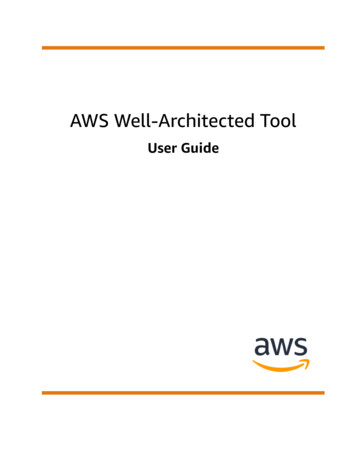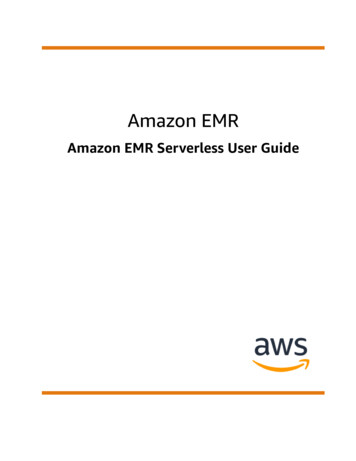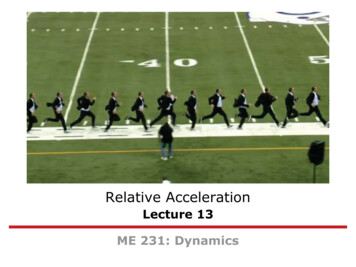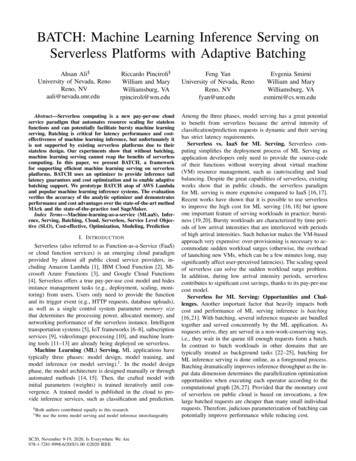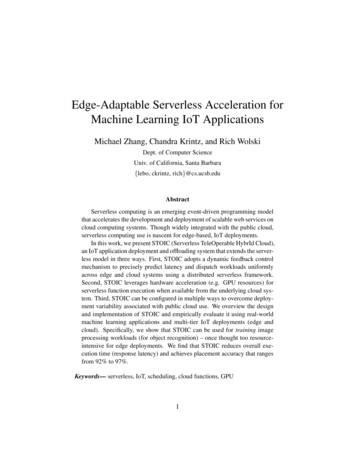
Transcription
Edge-Adaptable Serverless Acceleration forMachine Learning IoT ApplicationsMichael Zhang, Chandra Krintz, and Rich WolskiDept. of Computer ScienceUniv. of California, Santa Barbara{lebo, ckrintz, rich}@cs.ucsb.eduAbstractServerless computing is an emerging event-driven programming modelthat accelerates the development and deployment of scalable web services oncloud computing systems. Though widely integrated with the public cloud,serverless computing use is nascent for edge-based, IoT deployments.In this work, we present STOIC (Serverless TeleOperable HybrId Cloud),an IoT application deployment and offloading system that extends the serverless model in three ways. First, STOIC adopts a dynamic feedback controlmechanism to precisely predict latency and dispatch workloads uniformlyacross edge and cloud systems using a distributed serverless framework.Second, STOIC leverages hardware acceleration (e.g. GPU resources) forserverless function execution when available from the underlying cloud system. Third, STOIC can be configured in multiple ways to overcome deployment variability associated with public cloud use. We overview the designand implementation of STOIC and empirically evaluate it using real-worldmachine learning applications and multi-tier IoT deployments (edge andcloud). Specifically, we show that STOIC can be used for training imageprocessing workloads (for object recognition) – once thought too resourceintensive for edge deployments. We find that STOIC reduces overall execution time (response latency) and achieves placement accuracy that rangesfrom 92% to 97%.Keywords— serverless, IoT, scheduling, cloud functions, GPU1
1IntroductionServerless computing (also known as Functions-as-a-Service (FaaS)) [1, 2, 3] is a popular cloud service for hosting and automatically scaling applications. Originally designedfor web services [4, 5], serverless computing defines a simple, event-driven programmingmodel and cloud platform with which developers write simple, short-lived functions thatare invoked by the platform in response to specific system-wide events (e.g. storage updates, notifications, messages received, changes in state, custom events, etc.). Serverlessplatforms automatically configure and provision isolated execution environments (typically via Linux containers) on-demand and users pay only for the resources their functions use during execution. Given its success to date, public cloud providers and opensource communities have released multiple serverless platforms with similar functionality [1, 3, 6, 7, 8, 9].Moreover, serverless computing has been extended to work at the “edge” of the network to reduce the response latency and bandwidth associated with public cloud use bydata-driven applications (e.g. those that target the Internet of Things (IoT)) [10, 11, 12].Doing so is challenging, however, because computing and storage resources are scarceat the edge relative to resource-rich public and private clouds. Moreover, public/privateclouds may offer specialized hardware (e.g. GPUs) that can significantly speed up machine learning applications, which is not commonly available in resource-restricted edgeclouds.In this paper, we investigate the use of serverless computing across the edge and publiccloud deployments (hybrid cloud settings). We develop a scheduling system, called theServerless TeleOperable Hybrid Cloud (STOIC), which automatically places and deploysfunctions across these systems aiming to reduce the total execution time latency (versususing either system in isolation). We specifically target image-based, object recognitionusing Tensorflow (for training and inference) in this work.STOIC automatically places serverless functions at the edge (without GPUs) or inpublic cloud instances (equipped with 1 GPUs) using predicted latency. We use the system to perform online training and inference for batches of images from motion-triggered,camera traps that capture images of wildlife in remote locations, with intermittent Internetconnectivity.STOIC has two placement scenarios: the first places functions only at the runtime withthe least predicted latency, whereas the second places functions concurrently at both edgeand public cloud, but then terminates public cloud execution if/when it determines that theedge will finish sooner. The former scenario is called Selector mode. The latter scenario,called Duplicator mode, is useful when the cloud and/or network performance used fordeployment is intermittent or highly variable, or when executing at the edge incurs no costor other penalty – to ensure that progress is made. Our results show that STOIC speeds upthe total response time of the application by 3.3x versus a baseline scenario. In selector2
mode, STOIC achieves a placement accuracy of 92% relative to the optimal placement.In duplicator mode, STOIC accuracy is 95% for 2 GPUs and 97% (versus optimal) for 1GPU cloud deployments over a 24-hour period.In summary, with this paper, we make the following contributions. We design and implement a serverless framework that spans heterogeneous edgeand cloud systems, serving IoT requests, and leveraging GPU acceleration; We investigate feedback control mechanism and various analytical methodologiesto precisely model the unstable edge and public cloud environments; and We empirically evaluate the efficacy of using this extended serverless model formachine learning applications and IoT deployments.In the following sections, we first discuss the related work (Section 2). We thenpresent the design and implementation of STOIC (Section 3), following by our experimental methodology and empirical evaluation of the system and application workloads,using a distributed serverless deployment (Section 4). Finally, we present our conclusionsand future work plans (Section 5).2Related WorkWe have explored an initial design and scheduler for STOIC in [13]. The work hereinextends this early work with a new scheduling system and consideration of both individualand concurrent edge-cloud placements.A significant body of work [14, 15, 16] has explored low-latency geo-distributed dataanalytics and mobile-cloud offloading – which we take as inspiration for the STOIC design. One relevant approach is federated learning [17], by which a comprehensive modelis trained across heterogeneous edge devices or servers without exchanging local datasamples. Federated learning aims to address the security and networking concerns bykeeping the datasets local at devices, whereas STOIC intelligently offloads jobs acrossmultiple tiers of cloud infrastructure to further reduce latency.In addition, STOIC targets IoT systems and leverages serverless computing and GPUs.As such, other related work includes recent advances in machine learning infrastructure,serverless computing, GPU accelerators, and container-based orchestration services. [18]and [19] conduct a comprehensive survey on serverless computing including challengesand research opportunities. We share the same viewpoint that the use of the serverlessexecution model will grow for online training and inference applications. [20] providesa prototype for a deep learning model serving in a serverless platform. [21] provides another use case for accelerating serverless functions by GPU virtualization in data centers.Unique in our work, STOIC extends an existing serverless framework to support GPU3
Node SelectionOrchestrationQuality of ServiceTrust roughput/availabilitySmart ContractsVideo StreamingHCL-BaFogMultiChainDocker Swarmlatency/availabilityBlockchainSensor Data SharingSTOICDynamic Feedback LoopKubelesslatency/availabilityNautilusImage RecognitionTable 1: The comparison table of DECENTER, HCL-BaFog and STOIC.acceleration and distributed function placement across the edge and public clouds. [22]evaluates several serverless frameworks that use Kubernetes to manage and orchestrateuse of Linux containers. STOIC also integrates Kubernetes for container orchestration,which is lightweight, flexible, and developer-friendly. We concur that Kubernetes is apromising deployment infrastructure for serverless computing.Another relevant domain of related work is edge-to-cloud infrastructure enabling IoTdevice applications. [23] compares the processing time of face recognition between theedge device and smartphones. It concludes that edge devices perform comparably fasterand scales better as the number of images increases. We agree with this conclusion, andas such, we design STOIC to offload image processing workloads to both edge cloudsand public clouds. [24] proposes a distributed deep neural network that allows fast andlocalized inference at the edge device using truncated layers of a neural network. [25]defines edge cloud offloading as a Markov decision process (MDP) whose objective isto minimize the average processing time per job. Based on this setting, it provides anapproximate solution to MDP with a one-step policy iteration. Similar to this approach,[26] proposes a Global Cluster Manager for orchestrating network-intensive programswithin Software-Defined Data Centers (SDDCs) targeting high Quality of Service (QoS)and, further, [27] classifies available cloud deployment options by a stochastic Markovmodel, namely Formal QoS Assurances Method (FoQoSAM), to optimize the automatedoffloading process. Due to its practical utility, such a method can guarantee that QoSrequirements are satisfied. [28] proposes a fog computing platform (DECENTER) anda trust management architecture based on Smart Contracts. Related to this work, [29]develops an architecture (HCL-BaFog) by the blockchain functionality to share sensordata. Table 1 summarizes the properties of DECENTER, HCL-BaFog, and STOIC. Theseworks are complementary to STOIC and we are considering how to incorporate them intothe system as part of future work.Also complimentary to STOIC, are tracing, testing, repair, and profiling tools (whichSTOIC can leverage) for serverless systems. Multiple works track causal dependenciesacross distributed serverless deployments for use in optimization, placement, and datarepair [30, 31, 32, 33]. FaaSProfiler [34] integrates testing and profiling within a FaaSplatform. [35] proposes a security solution that applies reinforcement learning (RL) toprovide secure offloading to the edge nodes to prevent jamming attacks. These related4
Figure 1: The STOIC Architecturesystems can be combined with STOIC to provide a robust serverless ecosystem for distributed IoT devices.3STOICTo leverage hardware acceleration and distributed (multi-cloud) scheduling within a serverless architecture, we have developed STOIC, a framework for distributing and executinganalytics applications across multi-tier IoT (sensing-edge-cloud) settings. Specifically,STOIC optimizes the end-to-end process of packaging, transferring, scheduling, executing, and result retrieval for machine learning applications in these settings.Figure 1 shows the distributed components of STOIC. At the edge, STOIC gathersapplication input data, determines whether the lower application latency will be achievedby processing the data on the edge or in the cloud, and then actuates the application’scomputation (with the necessary data) using the “best” choice. The public cloud component manages whatever cloud resources are needed to receive the data from the edge,trigger the computation, and return the results to the edge. The edge and cloud systemsmirror each other, running Kubernetes [36, 37] overlaid with kubeless [38], to provide auniform infrastructure for the framework.Our system design is motivated by a need to classify wildlife images in a location5
where it is possible to site a relatively powerful edge system but where network connectivity is poor. In this paper, we report on the use of STOIC for processing images frommultiple, motion-triggered camera traps (sensors) deployed to a wildlife reserve currentlyused to study ecological land use.3.1Edge ControllerThe STOIC edge controller is a server that runs in an out-building at the reserve. It communicates wirelessly with the sensors and triggers analysis and computation upon theirarrival. The edge controller is connected to a research facility (which has full Internetconnectivity) via a microwave link. When a camera trap detects motion, it takes photosand persists the images in flash storage buffer, where human experts would label imagesfor training tasks. Periodically, sensors transfer saved photos to the edge controller. During a transfer cycle, the edge controller compresses and packages all images generatedand transfers the package to the public cloud, if/when necessary. STOIC runs on the edgecontroller and its executions are triggered by the arrival of image batches.As an intermediate computational tier between the sensors and the public cloud, theedge controller can be placed anywhere, preferably near the edge devices, to lower theresponse latency for the data processing and analytics applications. It consists of threemajor components: The cloud scheduler predicts the total latency based on historical measurementsfor each available runtime. The requester takes as input the runtime and cloud predicted by the scheduler tohave the least latency. The requester stores the image package in an object storageservice running in this cloud. It then triggers a serverless function (running in aKubernetes pod) via a RESTful HTTP request to process the images. The inquisitor monitors public cloud deployment time. To enable this, it periodically in the background deploys each runtime (using Kubernetes pods [39]) andrecords the deployment times in a database. No task/process is executed in thisprocess (the runtime is simply deployed and taken down). We use the inquisitor toestablish the historical time series for predicting the deployment latency of remoteruntimes.The edge cloud that we use in this study is deployed at a research reserve and is connected via the Internet. It consists of a cluster of three Intel NUCs [40] (6i7KYK), eachwith two Intel Core i7-6770HQ 4-core processors (6M Cache, 2.60 GHz) and 32GB ofDDR4-2133 RAM connected via two channels. The cluster is managed using the Eucalyptus cloud system [41], which mirrors the Amazon Web Services (AWS) interfaces forElastic Compute Cloud (EC2) to host Linux virtual machine (VM) instances and Simple6
Storage Service (S3) to provide object storage. The STOIC edge runtime uses Kubernetesand kubeless for serverless function execution and S3 (i.e. walrus) for object storage onthe edge cloud.3.2Public/Private CloudTo investigate the use of the serverless architecture with hardware acceleration, we employ a shared, multi-university, GPU cloud, called Nautilus [42], as our remote cloudsystem. Nautilus is an Internet-connected, HyperCluster research platform developed byresearchers at UC San Diego, the National Science Foundation, the Department of Energy, and multiple, participating universities globally. Nautilus is designed for runningdata and computationally intensive applications. It uses Kubernetes [37] to manage andscale containerized applications. It also uses Rook [43] to integrate Ceph [44] for objectstorage. As of May 2020, Nautilus consists of 176 computing nodes across the US anda total of 543 GPUs in the cluster. All nodes are connected via a multi-campus network.In this study, we consider Nautilus a public cloud that enables us to leverage hardwareacceleration (GPUs) in the serverless architecture. The STOIC cloud/GPU runtimes useKubernetes and kubeless for serverless function execution and Ceph for object storage onthe public cloud.A major challenge that we face with such deployments is hardware heterogeneity andperformance variability. On Nautilus, we have observed 44 different types of CPU (e.g.Intel Xeon, AMD EPYC, among others) and 9 GPU types (e.g. Nvidia 1080Ti, K40,etc.). Both CPUs and GPUs of different types have different performance characteristics.Moreover, the object storage service is run on dedicated nodes that are distributed globally.This heterogeneity impacts application execution time (which STOIC attempts to predict) in three significant ways. First, different CPU clock rates affect the transfer ofdatasets from the main memory to GPU memory. Second, there is significant latencyand performance variability between runtimes and the storage service (which hold thedatasets and models). Third, the multi-tenancy of nodes (common in public cloud settings) allows other jobs to share computational resources with our applications of interestat runtime.These three factors negatively make it difficult for users to determine which runtime touse (to reduce application turn-around time) and when to execute locally (avoiding publiccloud use altogether). With STOIC, we address these challenges via a novel schedulingsystem that adapts to this variability. In our results, we ensure reproducibility (avoidingnetwork performance variability) by confining nodes and GPUs (still heterogeneous) to asingle Nautilus region.7
3.3Runtime ScenariosTo schedule machine learning tasks across hybrid cloud deployments, we define four runtime scenarios: (A) Edge - A VM instance on the edge cloud with AVX2 [45] support; (B)CPU - A Kubernetes pod on Nautilus containing a single CPU with AVX2 support [45];(C) GPU1 - A Kubernetes pod on Nautilus containing a single GPU; (D) GPU2 - AKubernetes pod on Nautilus containing two GPUs. STOIC considers each of these deployment options as part of its scheduling decisions. Users can parameterize STOIC withtheir choice of deployment or allow STOIC to automatically schedule their applications.3.4Execution Time EstimationAs depicted in Figure 1, the STOIC’s edge controller listens for image batches from theremote camera traps and makes machine learning job requests. After a preset period(parameterizable but currently set to an hour), STOIC estimates total response time (Ts )of a requested batch, based on 4 different runtime scenarios. The total response time (Ts )includes data transfer time (Tt ), runtime deployment time (Td ), and the correspondingprocessing time (Tp ). We define total response time (Ts ) as Ts Tt Td Tp .3.4.1Transfer time (Tt )Tt measures the time spent in transmitting a compressed batch of images from the edgecontroller to edge cloud and public cloud. We calculate transfer time as Tt Fb /Bcwhere Fb represents the file size of batch and Bc represents the bandwidth at the momentprovided by a bandwidth monitor at the edge controller.3.4.2Runtime deployment time (Td )Td measures the time Nautilus uses to deploy requested kubeless function. Since thescarcity of computation, it is common that multi-GPU runtime takes longer to deploythan single-GPU and CPU runtimes. Note that, for edge runtime, the deployment timezeroes out since STOIC executes the task locally in the edge cloud.Because Nautilus is a shared cloud system, we observe significant variation in deployment time on Nautilus for different times of the day. To accurately predict deployment time, we analyze deployment times as a time series using three methods: (1) autoregression modeling, (2) average sliding window, and (3) median sliding window. Autoregression [46] is a time series modeling technique based on the auto-correlation betweenprevious time steps and the following ones. The average sliding window is the movingaverage [47] scanning through the time series by a fixed-length window. Similarly, themedian sliding window captures the moving median cross the time series. All window8
Figure 2: The Mean Absolute Error (MAE) of deployment time for the GPU1runtime. The x-axis is the window (history) size. The left subplot is MAE whenSTOIC uses the average sliding window, the right subplot is MAE when STOICuses the median sliding window.ModelingAutoRegAutoRegAutoRegAvg. SWAvg. SWAvg. SWMed. SWMed. SWMed. indow 7148.00616.525.965.66814.48Table 2: Mean Absolute Error of three time series modeling methods for runtimedeployment time: auto-regression (AutoReg), average sliding window (Avg. SW),and median sliding window (Med. SW). The median sliding window achieves thelowest minimum MAE at optimal window size (that with the lease MAE) for allthree runtimes.9
sizes used for three modeling processes are optimized based on historical data of deployment time (Td ) in January 2020. We then compare the minimum Mean Absolute Error(MAE) from each to select the best modeling methodology.In this example, we consider a time series of 1244 data points for each runtime. Figure 2 shows representative analytics for GPU1 deployment time, in which MAE oscillatesas window size varies. We observe that the median sliding window reaches a lower minimum MAE than the average sliding window at optimal window size. As listed in Table 2,all three runtimes achieve the lowest minimum MAE using the median sliding window.Therefore, STOIC adopts this methodology for deployment time prediction.The inquisitor measures and records deployment time for each public cloud runtimeevery minute (called the inquisitor period). After the inquisitor records 10 new measurements (called the calibration period), the scheduler recomputes the window size over theprevious 100 measurements that result in the minimum MAE. It then uses this minimumMAE window size to estimate of deployment time when jobs arrive. The inquisitor period,calibration period, and maximum window size are all modifiable.3.4.3Processing time (Tp )Tp is the execution time of a specific machine learning task and the target of task scheduling across the hybrid cloud. STOIC formulates a linear regression on execution timehistories of STOIC jobs, and uses it to predict processing time relative to input (imagebatch) size. Specifically, we use Bayesian Ridge Regression [48] due to its robustness toill-posed problems (relative to ordinary least squares regression [49]). STOIC queries thedatabase for the most recent processing time data (e.g. 10 data points) for each regression. This ensures that the parameters of the regression line reflect the current runtimeperformance.As part of our investigations into this approach, we have found that this approach ishighly susceptible to outliers. The root cause of these outliers is sporadic congestion andmaintenance (for nodes, networking, etc.) of the public cloud. Deviating significantlyfrom the average, outliers skew the regression line and overestimate the runtime latencyfor extended periods (due to the windowing approach). We thus augment regression usinga random sample consensus (RANSAC) technique [50], which iteratively removes outliersfrom the regression. The algorithm 1 illustrates our RANSAC approach in STOIC.3.4.4AdaptabilityTo verify that STOIC’s estimation of execution time captures the actual latency of thepublic cloud, we execute the application 50 times with 150-image batch using the GPU1runtime. Depicted in Figure 3, we observe that actual total latency varies significantly andpredicted total latency has a non-negligible difference from the actual total latency at the10
Algorithm 1: Random Sample Consensus1234567891011121314151617Data: (1) Observation set of Process time Tp(2) Bayesian Ridge Regression model M(3) Minimum sample size n(4) Residual threshold t(5) Maximum iteration k(6) Required inlier size d(7) Minimum Root Mean Square Error eResult: A set of parameters that best fits the datawhile iterations k docurr sample : n data points from observation;curr model : M regressed on curr sample;fit data : empty set;for every data point p in curr sample doif error of p t thenp fit data;endif fit data size d thencurr error : average error in fit data;if curr error ¡ e thenUpdate M and eelseIncrement iterationendendreturn M11
Figure 3: The comparison of predicted and actual total latency on 50 GPU1 benchmark executions with 150-image batch size. The x-axis is the epoch time and they-axis is the total latency.First HalfSecond HalfDeployment Td42.7%29.2%Processing Tp11.2%5.3%Total Ts15.8%9.2%Table 3: The percentage mean absolute error (PMAE) of deployment, processing,and total latency. PMAE is a latency-normalized metric and calculated as MAEdivided by mean latency, which indicates the residual in a measured period. Thedecline of three latency metrics in the second half demonstrates the adaptabilityof STOIC.beginning of the experiment. However, over time, as STOIC learns the various latenciesof the system, the difference is significantly reduced. In Table 3, we report the percentagemean absolute error (PMAE), which we compute as the MAE divided by mean latency.The decrease in all three PMAE values in the second half of the execution trace also showSTOIC’s adaptability.3.5Workload GenerationTo drive our empirical evaluation in faster-than-real time, we construct a workload generator from image batch histories (traces) collected by our camera traps. We consider theset of images that occur together within an hour (i.e. due to motion events) a batch. Ourcamera trap trace, starting on July 13th, 2013 and ending Jan. 15th, 2017, comes from afixed camera located at a watering hole in a remote area of our research reserve. The tracecontains images of bear, deer, coyote, puma, and birds as well as wind-triggered emptyimages and other animals.12
Figure 4: Wildlife Hourly Activity Level (left graph) and its Conditional Empirical Cumulative Distribution Function (right graph). The left graph demonstratesthe mean activity level of wildlife throughout the daytime. Based on the curve, 1PM and 8 PM are two peak hours of animal activities. The right graph shows theempirical CDF, which STOIC randomly samples for image batches to drive ourfaster-than-real time empirical evaluation of the system.After excluding camera maintenance periods (gaps), we extract 1136 effective days(27264 hours) of data. The maximum size of hourly image batch is 2450, whereas theminimum size is unsurprisingly zero, which constitutes 18139 hours out of 27264 hours(66.53%). On average, an hourly image batch size contains 25 images. The left graph inFigure 4 illustrates the wildlife hourly activity level based on the image batch size. Weinfer from the curve that 1 PM and 8 PM are two peak hours of animal activity.Specifically, we construct a conditional empirical cumulative distribution function(ECDF) based on the probability definition of P r(x K x 0), where x is the imagebatch size and K is the cutoff value. This conditional ECDF effectively represents thetrajectory of the animal activity level and makes the evaluation empirical. The right graphin Figure 4 plots the conditional ECDF. The x-axis is the image batch size ranging fromzero to 2450, whereas the y-axis is the cumulative probability. The STOIC workloadgenerator draws image batch sizes by randomly sampling this ECDF. Using this process,we are able to evaluate and conclude by replaying the image stream from the camera trapsin fast-than-real time for the purposes of comparative evaluation.13
3.6ImplementationWe implement STOIC using Golang [51]. Golang provides high-performance execution(vs scripting languages) and a user-friendly interface [52] to Kubernetes and databasetechnologies. STOIC currently supports machine learning applications developed usingthe TensorFlow framework [53] and can be easily extended to permit other machine learning libraries.As mentioned previously, the STOIC serverless architecture leverages kubeless [38].As a Kubernetes-native serverless framework, kubeless uses the Custom Resource Definition (CRD) [54] to dynamically create functions as Kubernetes custom resources andlaunches runtimes on-demand. For specific machine learning tasks that STOIC executes,we build custom Docker images that we upload to Docker Hub [55] in advance. Whenthe function controller receives a task request, it pulls the latest image from Docker Hubbefore launching the function. This deployment pipeline makes the runtime flexible andextensible for evolving applications.To leverage the computational power of our CPU systems, we compile Tensorflowwith AVX2, SSE4.2 [45], and FMA [56] instruction set support. We use this optimizedversion of Tensorflow on both the edge and public clouds.To enable GPU access by serverless functions (available in the public cloud), we equipour Docker container with NVIDIA Container Toolkit [57]. This includes the NVIDIAruntime library and utilities, which link serverless functions to NVIDIA GPUs. We alsoinstall CUDA 10.0 and cuDNN 7.0 to support the machine learning libraries.3.7WorkflowSTOIC considers two workflows upon receiving an image batch: selector mode and duplicator mode. Both are depicted in Figure 5. In selector mode, STOIC predicts the totalresponse times (Ts ) of the four deployment options: Edge, CPU, GPU1, and GPU2. Itthen selects the runtime with the shortest estimated response time and deploys it locally(Edge) or remotely (non-Edge). Once deployed, the pod notifies the STOIC requester atthe edge which then triggers the serverless function via an HTTP request. When the taskcompletes, the pod notifies the requester, which retrieves the results and runtime metricsfrom the deployment and stores them in the database for use by the scheduler.To handle deployment failure, STOIC implements a retry mechanism using exponential back-off. Starting at 100 milliseconds, STOIC waits 2X length of time for retryingthe deployment on Nautilus. After 10 failed attempts, STOIC claims timeout and returnsan error.STOIC also attempts to reduce startup time (i.e. cold starts) at both the edge andpublic cloud. On the edge cloud, STOIC creates a standby pod to serve the incomingrequest upon application invocation. On the public cloud, STOIC triggers a function with14
Figure 5: The selector and duplicator modes of STOIC
Machine Learning IoT Applications Michael Zhang, Chandra Krintz, and Rich Wolski Dept. of Computer Science Univ. of California, Santa Barbara flebo, ckrintz, richg@cs.ucsb.edu Abstract Serverless computing is an emerging event-driven programming model that accelerates the development and deployment of scalable web services on cloud computing .
